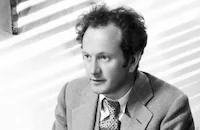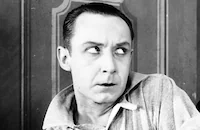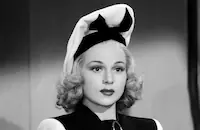A Girl, a Guy and a Gob

Brief Synopsis
Cast & Crew
Richard Wallace
George Murphy
Lucille Ball
Edmond O'brien
Henry Travers
Franklin Pangborn
Film Details
Technical Specs

Synopsis
When Stephen Herrick, a sedate, mild-mannered shipping magnate, loses his opera tickets, Mrs. Grange, the aggressive mother of his fiancée Cecilia, insists upon being seated in the Herrick box anyway. Upon finding the Duncan family ensconsed in their box, Mrs. Grange incites an argument that culminates with Dot Duncan hitting Stephen with her handbag. After the Herrick party surrenders their seats to the Duncans, Dot realizes that her brother Pigeon found Stephen's lost tickets, and the embarrassed Duncans flee the theater. The next day, at the offices of Herrick and Martin, Stephen is introduced to his new secretary, Dot Duncan. Recognizing Dot as his assailant from the previous evening, he dismisses her, but after she explains the confusion over the tickets, Stephen relents. Soon after, Dot's beau, wrestler Claudius J. "Coffee Cup" Cup, returns from the Navy, promising to settle down and not re-enlist. While Dot and Coffee Cup are strolling down the street one day, Coffee Cup spots his pal Eddie, who he boasts, can grow four inches just by stretching. Eddie's aptitude for elongation draws a crowd, and soon Coffee Cup is taking bets from the skeptical onlookers. Stephen is drawn into the group when Dot borrows five dollars from him, and when the contest ends in a brawl in which Stephen is knocked unconscious, Coffee Cup takes him to the Duncan house to recover. Stephen awakens to the chaos of the Duncan household as Coffee Cup practices his wrestling technique on Pigeon, Mrs. Duncan delivers a neighbor's baby and Ivory, a sailor, tinkles the piano keys. Stephen is so delighted by Dot's boisterous family and friends that he accompanies her and Coffee Cup to a dance hall and congas the night away, forgetting all about his date with the snobbish Cecilia. The next morning, an infuriated Cecilia bursts into Stephen's office and finds Dot, who has just fallen from a stepstool, in Stephen's arms. Stephen ignores Cecilia's demand that he fire Dot because he has begun to fall in love with her. One night while working late, the pair listen to a radio broadcast of Coffee Cup's wrestling match, and when Coffee Cup is proclaimed the winner, Dot announces that his winnings will finance their wedding. Dot's matrimonial plans are postponed, however, when Pigeon admits to betting on Coffee Cup's opponent and losing all their money. The wedding plan is revived after Coffee Cup wins a piano at a raffle and plans to pawn it for an engagement ring, but the piano rolls into the street and is run over by a truck. Next, Coffee Cup decides to raise the money by employing Eddie's stretching virtuosity, but instead ends up in jail for inciting a riot. When Abel Martin, Stephen's partner, comes to work battered from Eddie's latest brawl and tells Stephen that Coffee Cup is languishing in jail, Stephen bails him out and offers to buy the sailor's goodluck ring, knowing that the proceeds will pay for Dot's engagement ring. After Dot and Coffee Cup are engaged and Cecilia breaks her engagement to Stephen, Abel, an old sailor himself, encourages Stephen to pursue Dot. Stephen, ever the gentleman, concedes Dot to Coffee Cup, who asks him to be best man at the wedding. During the wedding rehearsal at the chapel, Coffee Cup misplaces the ring, and when he leaves the room to search for it, his sailor friends suggest that Dot is marrying the wrong groom. When Dot bursts into tears as Stephen approaches to kiss her good luck, Coffee Cup realizes that his friends were right and sends Stephen to speak to Dot. Coffee Cup then flees the chapel on his motorcycle, with Stephen pursuing him by cab. After Stephen's cab runs Coffee Cup's cycle off the road and into a petshop, the two men fight over who should marry Dot. The cab then speeds back to the chapel, where Coffee Cup deposits the unconscious Stephen along with a note to Dot explaining that he is re-enlisting in the Navy and Stephen is in love with her.

Director

Richard Wallace
Cast

George Murphy

Lucille Ball

Edmond O'brien

Henry Travers

Franklin Pangborn
George Cleveland
Kathleen Howard

Marguerite Chapman
Lloyd Corrigan
Mady Correll
Frank Mcglynn
Doodles Weaver
Frank Sully

Nella Walker

Richard Lane

Irving Bacon
Rube Demarest
Charles Smith
Nora Cecil
Bob Mckenzie

Vince Barnett
Bert Moorhouse

George Mckay
James Bush
Jack Lescoulie
Art Rowlands
Chuck Flynn
Joe Bernard
Wade Boteler

Fern Emmett
Earl Hodgins
Effie Anderson
Henry Roquemore
Joseph "corky" Geil

Carol Hughes

Charles Irwin
Gaylord Pendleton
Warren Ashe
Eddie Arden
Jimmy Cleary
Blue Washington
George Lollier
Frank O'connor
Ralph Brooks
Cy Ring
Tommy Quinn
Ed Peil
Tom Costello
Alex Pollard
Dewey Robinson
Jack Dorrance
Ronnie Rondell
Eddie Hart
Hal K. Dawson
Snub Pollard
Homer Dickinson
Harry Depp
Ed Dearing
Gertrude Short
Leon Belasco
Andrew Tombes
Geraldine Fisette
Jim Spencer
Sam Appel
Harry Kema
Frank Mills

Lloyd Ingraham
Walter Byron
Irene Colman
Mary Field
George Lloyd
George Chandler
Vic Potel
Bud Jamison
Crew
James H. Anderson
George Crone
Albert D'agostino
Merritt Gerstad
Bert Granet
Victor Heerman
Grover Jones
Harold Lloyd
Sarah Y. Mason
Hugh Mcdowell Jr.
Russell Metty
Van Nest Polglase
Frank Ryan
Darrell Silvera
Edward Stevenson
Vernon L. Walker
Roy Webb

Videos
Movie Clip




Hosted Intro
Film Details
Technical Specs

Articles
A Girl, A Guy and a Gob - A Girl, a Guy and a Gob
As for A Girl, a Guy, and a Gob, the girl in question is, of course, Lucille Ball. She plays a secretary named Dot. The guy is Edmond O'Brien, Ball's boss at a shipping firm. And the gob is George Murphy, a sailor called "Coffee Cup." (A gob, for those not up on their military slang, is a term for a sailor in the U.S. Navy.) "Coffee Cup" is set to marry Dot when her boss comes into the picture and romantic complications ensue.
According to a pre-production item in The Hollywood Reporter, the film's original cinematographer was Merritt Gerstad, who was hired to photograph the production's first two weeks. After that, Russell Metty, the credited cinematographer, took over, having finished up work on No, No Nanette (1940). Also of note was the film's producer who was none other than silent comedian Harold Lloyd. A Girl, a Guy, and a Gob was the first of two films produced by Lloyd for RKO and the first film he produced but did not star in. Lloyd's second RKO production was the Kay Kyser vehicle My Favorite Spy (1942). Reportedly Lloyd was a hands-on producer, who dropped by the set of A Girl, a Guy, and a Gob and offered comedic advice. Edmond O'Brien's handkerchief bit, for example, had been used previously in Lloyd's Welcome Danger (1929).
RKO borrowed George Murphy from MGM for A Girl, a Guy, and a Gob. Murphy was well established in his career by this time, having appeared in films like Broadway Melody of 1938 (1937) and Little Nellie Kelly (1940) with Judy Garland, as well as dancing with Shirley Temple in Little Miss Broadway (1938). Edmond O'Brien, on the other hand, was just beginning his career when he made A Girl, a Guy, and a Gob. It was only his third film but lacked the prestige of his previous part in the classic 1939 version of The Hunchback of Notre Dame.
Also starring in A Girl, a Guy, and a Gob is Henry Travers, whose impressive screen credits include High Sierra (1941), Mrs. Miniver (1942), The Bells of St. Mary's (1945) and perhaps his most memorable role as angel Clarence in It's a Wonderful Life (1946). Character actor Franklin Pangborn also pops up in A Girl, a Guy, and a Gob as the pet store owner. Pangborn appeared in hundreds of films, beginning in silent pictures. He made his mark in The Bank Dick (1940) and Never Give a Sucker an Even Break (1941) with W.C. Fields, and played a memorable role in Sullivan's Travels (1941).
Producer: Harold Lloyd
Director: Richard Wallace
Screenplay: Gerald Drayson Adams (story), Grover Jones (story), Bert Granet, Frank Ryan
Cinematography: Russell Metty
Film Editing: George Crone
Art Direction: Van Nest Polglase
Music: Roy Webb
Cast: George Murphy (Claudius J. Cup), Lucille Ball (Dorothy Duncan), Edmond O'Brien (Stephen Herrick), Henry Travers (Abel Martin), Franklin Pangborn (Pet shop owner).
BW-90m.
by Stephanie Thames

A Girl, A Guy and a Gob - A Girl, a Guy and a Gob
Quotes
Trivia
Merritt B. Gerstad was director of photography for the first two weeks of production, while Russell Metty completed filming No, No, Nanette (1940).
Notes
The working title of this film was Three Girls and a Gob. According to a pre-production news item in Hollywood Reporter, John Howard was originally slated for the role of a "rich boy," but prior commitments prevented his appearance. Another news item in Hollywood Reporter notes that Merritt Gerstad was assigned to photograph the first two weeks of production while Russell Metty, the photographer credited on screen, completed the filming of No, No Nanette (see AFI Catalog of Feature Films 1931-40; F3.3161). The Film Daily review mistakenly identified Richard Jones as director. This was the first film produced by Harold Lloyd in which he did not star. George Murphy was borrowed from M-G-M for this picture.















